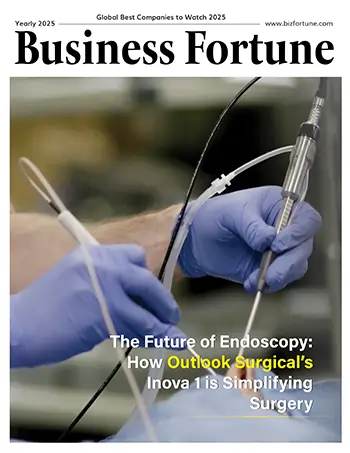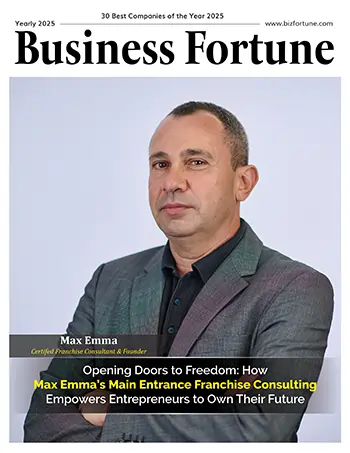Home Industry Travel and Hospitality How Digital Check-In Is Transf...
How Digital Check-In Is Transforming the Guest Experience — and Why It Hasn’t Scaled Yet
Travel and Hospitality

Business Fortune
27 June, 2025
-Iana Petrova
About the Author: Iana Petrova is a TravelTech executive with over a decade of experience driving digital transformation in the hospitality industry.
A New Standard or Still a Rarity?
Checking into a hotel without approaching the front desk? Five years ago, that sounded futuristic. Today, it’s technically possible in nearly any hotel. Yet outside major chains, most properties still rely on paper forms, passport copies, and long lines after a flight.
Modern guests no longer expect just “a place to stay” — they want a contactless, convenient, and intuitive scenario where check-in isn’t a separate chore but a seamless extension of their booking experience. And the younger and more mobile the audience, the higher the expectation.
So why hasn’t this already-available technology become the industry norm?
In this article, I’ll share how digital registration is reshaping service expectations, how the most agile players are already adopting it — and what’s preventing widespread implementation.
What Digital Check-In Looks Like from the Guest’s Perspective
The ideal check-in process for a guest looks like this:
They book a room → receive confirmation → complete pre-check-in online → get a mobile key or PIN code → enter the room without visiting the front desk.
No lines. No paperwork. No stress. Everything happens on their phone in just a few taps.
Digital check-in removes friction from the moment of arrival. It’s especially valuable:
- after long flight,
- during late-night arrivals,
- when there’s a language barrier,
- or simply for guests who prefer minimal interaction.
These scenarios are already a reality in major hotel chains like Hilton (via Hilton Honors), Marriott (Bonvoy), and Hyatt — as well as across short-term rentals like Airbnb and serviced apartments with keyless entry.
But the key insight is this: once a guest experiences seamless check-in, any return to paper forms and queues feels like a step backward.
It’s no longer a “wow” moment. It’s the new baseline.
What Hotels Gain: Digital Check-In Isn’t Just Convenient
Digital check-in isn’t just a guest-friendly perk — it’s a powerful operational tool for hotels. Here’s what it brings to the table:
-
Lower staffing costs.
Automation reduces the need for night-shift staff, streamlines peak-time check-ins, and allows front desk teams to focus on upselling and guest service instead of paperwork. -
Faster turnover and smoother arrivals.
With pre-check-in and mobile keys, wait times are reduced, room turnover is faster, and guests arrive with less stress — especially during busy periods. -
Fewer errors and less human friction.
No misread handwriting, no lost forms. Guest data goes directly into the PMS or CRM, eliminating manual data entry and mistakes. -
Improved loyalty and satisfaction.
Guests who don’t have to wait in line or fill out forms upon arrival rate their experience higher — boosting your review scores and increasing repeat bookings. -
Higher booking conversion.
When a hotel offers digital check-in, especially on mobile, guests are more likely to complete their reservations — because it signals modernity and ease. -
Legal and data compliance.
Every step is documented, timestamped, and exportable for audits or regulatory reporting — especially important in regions with strict guest registration laws.
All of this makes digital check-in not just a convenience feature, but an integral part of a modern, guest-centric service strategy — a core element of customer experience (CX) design.
Where It Breaks: Why Digital Check-In Isn’t Scaling Yet
Despite its clear advantages, digital check-in is still far from mainstream. Why? The problem isn’t with the technology itself — it already exists. The real obstacles lie in infrastructure and system fragmentation. Here’s what’s holding things back:
-
Disconnected tech ecosystems.
PMS platforms, lock systems, payment providers, mobile keys, analytics tools, and sales channels often come from different vendors. Without a shared standard, each integration becomes a custom project — costly and fragile. -
No universal check-in protocol.
There’s no “common language” for PMS, smart locks, and ID systems to communicate. As a result, digital check-in requires case-by-case integrations — which means high development costs and inconsistent reliability. -
OTA limitations.
Even if a hotel has automated everything internally, bookings coming from platforms like Booking.com or Airbnb often lack the necessary guest data. In some cases, digital registration simply isn’t possible without manual input. -
Resource constraints in SMBs.
Independent hotels rarely have a dedicated IT manager or in-house development team. Off-the-shelf, plug-and-play solutions that are truly compatible and user-friendly remain scarce. -
Fragmented UX.
Every chain has its own app. Every lock provider has its own interface. Every ID tool has its own process. Guests get lost in the download-login-forget cycle — and often revert to traditional check-in simply because it’s easier.
The result?
Digital check-in exists, but it lacks an environment that supports wide adoption.
My Experience: Why Unified Entry Points and Standards Actually Work
In my professional experience, I’ve led projects where we didn’t just implement technology — we helped define industry standards and create universal entry points that opened the door to new digital guest journeys. And I can say with confidence: this approach works.
One such project was our integration of Bnovo with Google Hotel Ads. Prior to our work, Russian hotels couldn’t appear in Google Travel or on Google Maps with direct booking capabilities. I initiated and led the certification of Bnovo as the first official Google Hotel Ads partner in Russia.
But the real value wasn’t just more bookings — it was the creation of an entirely new guest flow:
-
Search for a hotel in Google →
-
Booking via Bnovo’s booking engine on hotel’s website →
-
Complete pre-check-in online →
-
Arrive and access the room without visiting the front desk
Google became the first link in a seamless chain: search → booking → registration → digital access.
Another key initiative was the development of our OTA Gateway — a unified integration platform for developers. It became a kind of industry protocol, enabling dozens of third-party services to connect to the Bnovo PMS: smart locks, payment systems, ID platforms, CRM tools, messaging systems, and more.
What do these projects have in common?
They’re not about technology for technology’s sake. They’re about removing friction, enabling scale, and fostering ecosystems where everyone can plug in and build.
This is also a topic I actively contribute to as a member of smartsng.dev, an international software development association. In our community, we regularly discuss the urgent need for interoperability and data exchange standards across fragmented industries — hospitality included.
If the hospitality industry embraces more open entry points and shared standards like these, digital check-in will no longer be a premium feature — it will become the default.
What the Industry Needs: A Roadmap to Scalable Digital Check-In
For digital check-in to evolve from a niche feature to an industry-wide standard, we don’t need more tech — we need the right conditions for scale. Based on my experience, here’s what the industry truly needs:
-
Unified data formats.
Just like IATA in aviation or EDI in e-commerce, hospitality needs standard formats for bookings, guest IDs, and registration data. Without that, every integration remains a one-off project. -
A universal API protocol for PMS and smart locks.
Right now, every integration is custom. A shared, open API would allow any lock or ID service provider to instantly work with any compatible PMS. -
Integration with digital wallets.
Apple Wallet and Google Wallet could become the default for storing guest documents and verifying identity at check-in. These solutions already work in other industries — why not in hotels? -
Registration modules embedded in OTAs.
If a guest books through Booking.com or Airbnb, why not allow them to pre-register right there — without being redirected to another site?
The key insight?
Digital check-in will never scale unless it works out of the box — quickly, securely, and compatibly across platforms.
Digital Check-In Isn’t the Future — It’s the Missed Present
The technology for digital check-in already exists. We have PMS platforms, smart locks, APIs, cloud systems, ID verification tools, and digital wallets. We can book a flight in two minutes — so why does checking into a hotel still require forms, queues, and desk visits?
The real issue isn’t technical — it’s about standardization and ecosystem thinking.
As long as each hotel “bolts on” digital check-in manually, the process will remain expensive, fragile, and limited in reach.
But when a unified entry point like Google Hotel Ads or an open integration platform like OTA Gateway emerges, the dynamic shifts. Adoption becomes natural — even for smaller players.
My experience proves it:
If you give the market a usable, open infrastructure, the ecosystem will build itself.
And this applies not just to global hotel chains — but especially to independent and midsize hotels, where speed and adaptability are critical advantages.
Digital check-in is no longer a “nice-to-have.”
It’s a fundamental part of the guest experience.
And those who embed it early will not only serve better — they’ll compete stronger.


































